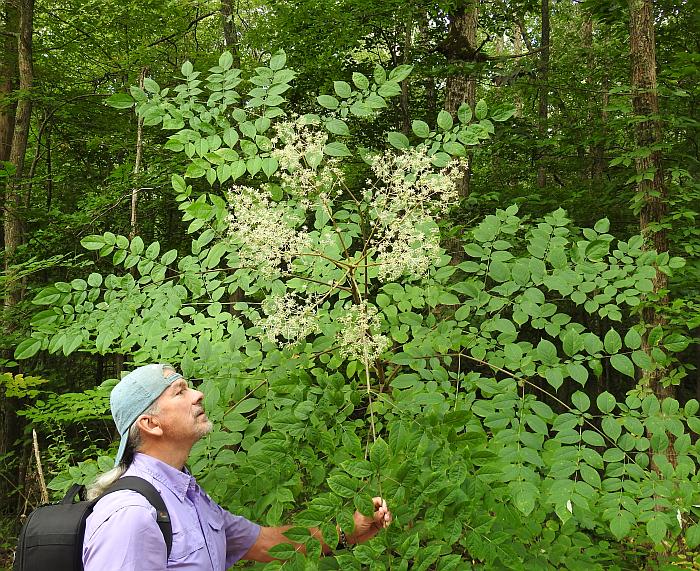Aralia spinosa L.
Devil's Walking Stick

Native
CC = 6
CW = 0
MOC = 11
© KBildner
Aralia spinosa L.Devil's Walking Stick | |
 |
Native CC = 6 CW = 0 MOC = 11 |
© KBildner |
|
Family - Araliaceae Habit - Shrubs or small trees, colonial from long rhizomes. Stems - Ascending or erect, to 12 m, woody, mostly unbranched, with stout spines, these mostly just below the leaf scars. Bark with shallow furrows and longitudinal plates, dark brown. Leaf scars linear, U-shaped, with several bundle scars in a single row.
Leaves - Alternate, large, to 1.5 m long, 2 or 3 times pinnately compound, the ultimate branches with 9-13 leaflets, the leaflets 4-13 cm long, ovate, toothed, the upper surface dark green, the undersurface lighter green, often with hairs or minute spines along the midvein.
Inflorescences - Large, terminal, highly branched panicles with numerous umbels, the branches hairy, usually turning red at maturity. Plants apparently polygamomonoecious, having staminate, pistillate, and perfect flowers on the same plant.
Flowers - Sepals 5 low, triangular teeth. Petals distinct, 5, 2-3 mm long, reflexed, white. Styles 5. Stamens 5.
Fruits - Globose drupes, 4-6 mm in diameter, black when mature.
Flowering - June - September. Habitat - Moist soils, woods, wooded slopes. Sometimes cultivated. Origin - Native to the U.S. Other info. - Native populations of this interesting species occur in the bootheel region of Missouri, and across the southern and eastern U.S. There are reports of native occurrences in Missouri as far north as St. Louis. Photograph taken at Kansas City Zoo, 6-24-99, and at Hanging Rock State Park, Stokes County, NC., 9-1-02 (DETenaglia); also at Morris State Park, Dunklin County, MO, 4-10-2018, Holly Ridge Conservation Area, Stoddard County, MO, 10-17-2017, 5-29-2020, 8-16-2021, and 5-23-2022 (SRTurner); also at Holly Ridge Conservation Area, Stoddard County, MO, 8-16-2021 (KBildner). |